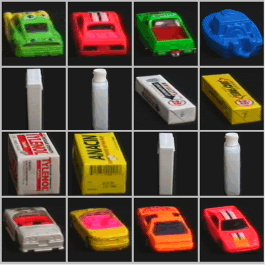3D Object Recognition
Recognition is achieved either by explicitly coding the recognition criteria in terms of low level structure, or through learning from examples. Learning algorithms incorporate subspace projections of higher dimensional data symbolically or using neural approaches.
Learning to Recognize 3D Objects
A learning account for the problem of object recognition is developed within the PAC (Probably Approximately Correct) model of learnability. The key assumption underlying this work is that objects can be recognized (or, discriminated) using simple representations in terms of “syntactically” simple relations over the raw image. Although the potential number of these simple relations could be huge, only a few of them are actually present in each observed image and a fairly small number of those observed is relevant to discriminating an object. We show that these properties can be exploited to yield an efficient learning approach in terms of sample and computational complexity, within the PAC model. No assumptions are needed on the distribution of the observed objects and the learning performance is quantified relative to its past experience. Most importantly, the success of learning an object representation is naturally tied to the ability to represent it as a function of some intermediate representations extracted from the image.We evaluate this approach in a large scale experimental study in which the SNoW learning architecture is used to learn representations for the 100 objects in the Columbia Object Image Database (COIL-100). Experimental results exhibit very good generalization and robustness properties of the SNoW-based method relative to other approaches. SNoW’s recognition rate degrades more gracefully when the training data contains fewer views and it shows similar behaviour also in some preliminary experiments with partially occluded objects.
- D. Roth, N.-H. Yang and N. Ahuja, Learning to Recognize Objects, IEEE Int. Conference on Computer Vision and Pattern Recognition (CVPR), Vol. I, Hilton Head, SC, June 2000, 724-731.
- M-H. Yang, D. Roth and N. Ahuja, Learning to Recognize 3D Objects with SNoW, Proc. Sixth European Conference on Computer Vision, Vol. 1, Dublin, June 2000, 439-454.
